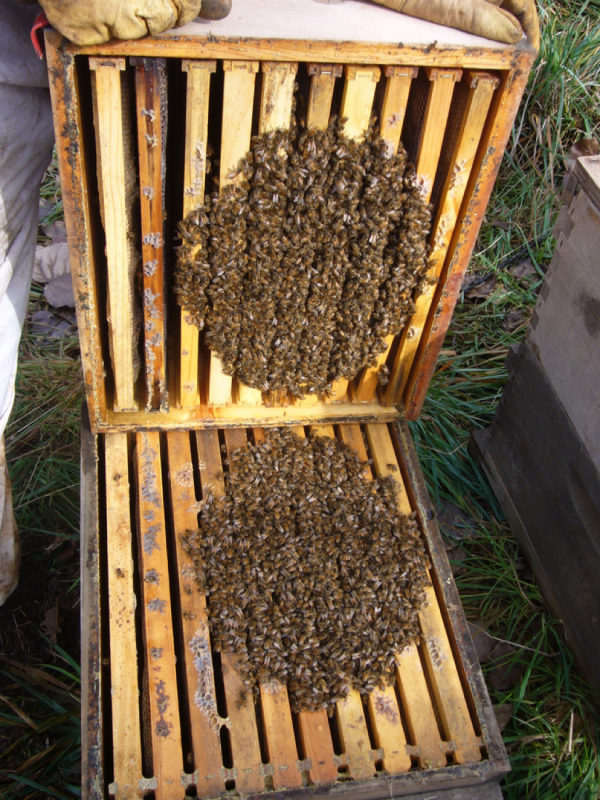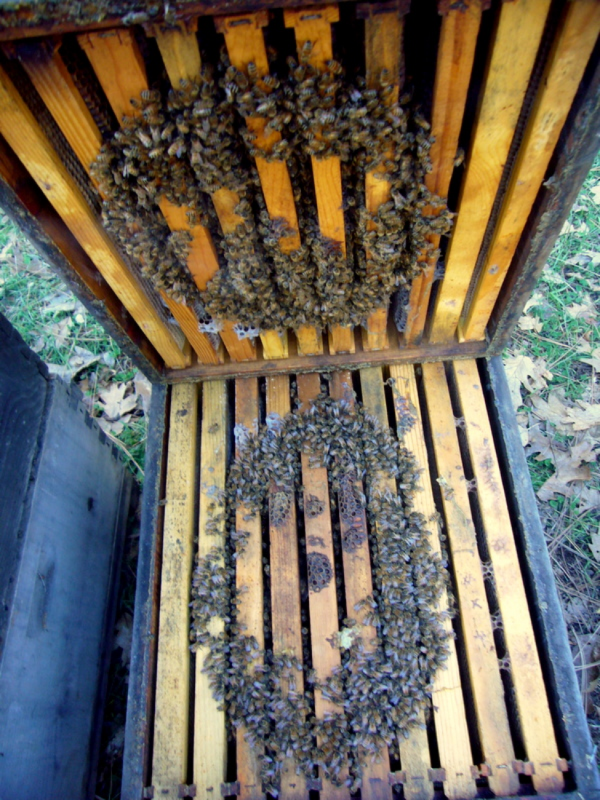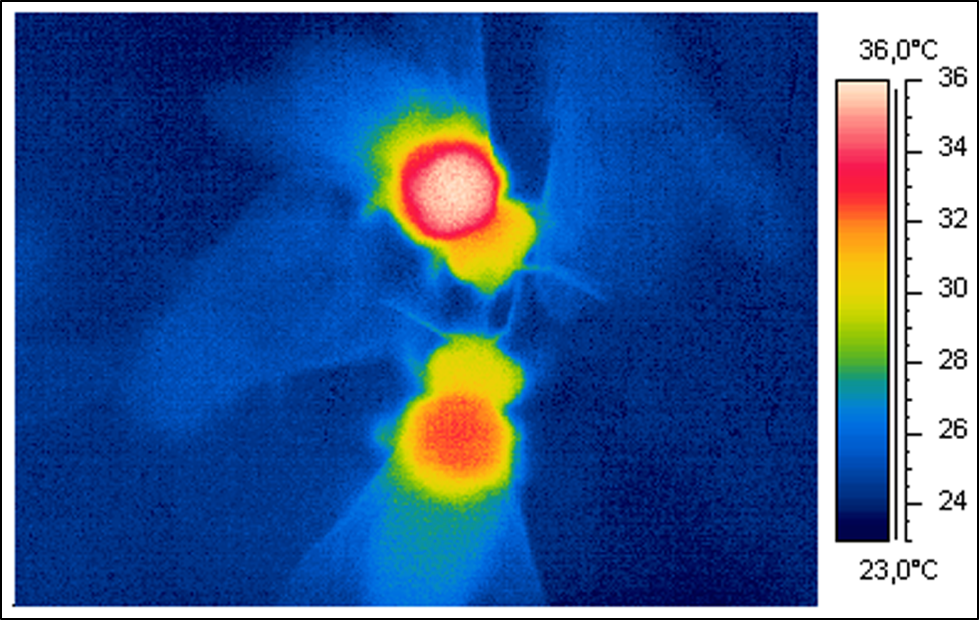Understanding Colony Buildup and Decline: Part 13a – The Physics of the Winter Cluster
Understanding Colony Buildup and Decline
Part 13a
The Physics of the Winter Cluster
Randy Oliver
ScientificBeekeeping.com
First published in ABJ July 2016
Updated in blue: 21 March 2019
In cold-winter locales, the temperature becomes too cool for workers to forage, and there is no nectar or pollen to be had anyway. In response, the European honey bee superorganism goes into a sort of “hibernation,” in order to conserve its food reserves until better times.
I don’t want to confuse, but there are two separate phenomena that take place during this phase of colony life:
- A cessation of broodrearing in response to a lack of incoming pollen, and
- A need for the colony to conserve energy during cold weather.
Both of the above phenomena occur concurrently in cold-winter climes, which may lead one to think that they are necessarily linked to time of season, day length, or temperature. In actuality, the response to lack of pollen and the response to cold temperature are independent of each other, but happen to overlap in cold-winter areas.
In arid subtropical or tropical areas, the colony may be forced to shift to into “survivor” (diutinus bee) mode during the late summer drought, due to lack of incoming pollen or nectar. Some races of the western honey bee (such as some African races or hybrids) respond by absconding and migrating to seek better pasture. Others (such as the Primorsky Russian bees I’ve kept, or European bees kept in Mexico) simply shut down broodrearing completely and wait it out until the bloom starts again in autumn, upon which they recommence broodrearing. Cold or short day length are not issues for these summer-dormant bees.
On the other hand is how the colony handles cold conditions. Solitary bee species typically overwinter as dormant pupae; bumblebees and social wasps overwinter as individual mated queens. Some Asian species of honey bee (e.g. Apis dorsata) migrate to warmer areas for the winter. In contrast, the European honey bee colony takes advantage of its substantial body mass (the cluster), and a habit of nesting in a protected tree cavity, to maintain a controlled temperature, similar to that of a homeothermic bird or mammal (a few of which also enter low-metabolism hibernation states, living off their stored fat). The honey bee is the only insect in cold-winter climates that maintains an elevated body temperature [1], and does so by living off its stored honey.
In this installment, I’ll discuss some biology, but mostly the physics of the cold-winter cluster. Although colony “dormancy” during summer drought is not constrained by severe cold, the physics involved are similar.
The Conundrum
Honey bees, being a tropical insect, need to maintain a body temperature of at least 60˚F in order to function (and a broodnest temperature in the range of 94-95˚F). In a cold-winter environment, this requires considerable metabolic production of energy, with honey reserves being the sole fuel source. The colony now faces a conundrum. The cluster must remain warm enough to defend itself and to move to its honey stores, yet conserve every calorie possible so as not to run out of food before the spring bloom. In addition, it must provide for a source of water to dilute that honey for consumption.
Over the course of evolution, the European honey bee has figured out how to accomplish all the above in the lightly-insulated cavity of a hollow tree. The better that we beekeepers understand the physics and biology involved, the better husbandry we can provide our colonies kept in artificial cavities (hives).
Description of the Winter Cluster
The winter cluster, having lost the last of its short-lived “summer bees,” now consists largely of long-lived diutinus bees. Due to as yet unclear behavioral cues, those bees eschew rearing brood (or rear it only sporadically) for roughly a month or so before (typically) reinitiating continuous broodrearing from January onward. During the dormant period, the bees in the colony arrange themselves into a cluster of the optimal size and shape to conserve heat and minimize their consumption of stores. The photos below (Figs. 1 & 2) shows bees in a tight cluster
Figure 1. The bees in this tight winter cluster in one of my hives appear to be uniformly distributed. But a puff of smoke will quickly indicate otherwise. This colony is not heavy on winter stores, as evidenced by the lack of full combs of honey in the upper box.
Practical application: my best success is with colonies that begin winter as a tight, nice-sized, very calm cluster centered mainly in the lower brood chamber, with plenty of full combs of honey above it. Colonies that are “awake,” or active under the lid, at winter inspection typically have a problem.
Figure 2. A few seconds after a puff of smoke, the loosely-clustered (and higher temperature) bees from the center have moved away, whereas the tightly-clustered bees in the “insulating shell” are still unable to budge. Within the confines of the insulating shell, surprising physical phenomena take place.
The bees in the insulating shell are relatively torpid due to their low thoracic temperature, and it takes them a minute or two to warm up. This reduces the colony’s ability to defend itself against wintertime marauders, such as mice. But the warm bees within the core are able to quickly push their way out to defend the colony if necessary—an advantage to keeping some soldiers on call (Fig. 3).
Figure 3. This marauding mouse got caught by the guards and stung to death. Since the carcass was too large for the bees to carry out, they chewed off the flesh, and mummified the skeleton in propolis.
The Physics of the Cluster
This winter cluster is quite efficient at conserving heat—a 12-frame cluster (6 lbs of bees) with an interior temperature of 94˚F uses only about 25 watts of energy at freezing temperature (Fig. 4; compare this heat output to that of a 25-watt lightbulb). This efficiency at conserving heat is on par with that of the best cold-adapted vertebrates. As observed by Southwick [2]: “The response of the bee cluster resembles that of the ptarmigan, a very well insulated bird (with down feathers even on its feet) inhabiting arctic and alpine regions of western North America.”
Figure 4. The energy use of colonies over winter can be measured in Watts/kg of bees. Southwick [[i]] found that although it varied widely from colony to colony, that it followed a general pattern. I here smoothed the averages of 42 of his 24-hr tests of colonies ranging from 2¼ –5½ lbs. Note that the metabolism of a clustered bee is lowest at around 40˚F, and rises as the temperature warms enough for the bee to become active, then drops again as ambient temperature approaches broodnest temperature.
[i] Southwick 1982 op cit. He quantified metabolic rates by measuring oxygen consumption. Note that he interprets his data differently in his 1983 paper.
Practical application: Southwick’s data [4] indicates that the honey bee colony is surprisingly energy efficient at ambient temperatures between freezing and 50˚F (10˚C), with energy use increasing outside that range. It is most miserly with its stores at around 40˚F (4˚C)—the temperature recommended for indoor wintering. This has practical applications (Table 1):
| Metabolic Rate (Watts/kg) | Honey consumed (lbs) over the winter |
| 10 | 36 |
| 15 | 53 |
| 20 | 71 |
Table 1. Estimated honey consumption by a 5-lb cluster of bees (roughly 10-frames with cluster broken) over a 152-day period from 1 Nov–1 April, at the indicated metabolic rate from the chart above (my calcs). Honey consumption would then increase greatly as the colony began rearing brood in earnest.
Practical application: in my experience, the least efficient wintering occurs at around 55-60˚F (13-16˚C), when it’s not quite warm enough to forage, yet not quite cold enough to form a tight cluster, but warm enough to establish a broodnest. Much energy is wasted as the colony breaks cluster each day in preparation for possible (and often fruitless) foraging.
There have, over the years, been a number of hypotheses and models proposed to explain how the cluster produces and regulates its temperature in order to realize such astounding energy efficiency [5].
Simpson (1961) explains:
A… fallacious assumption has been that, because the center of a cluster is hotter than the periphery, the bees at the center must be producing more heat than those further out. [But the laws of heat transfer tell us that if] the bees in the center are producing any heat at all, they must continually lose heat to the outer bees to remain at a steady temperature, and as heat can only pass from a hotter region to a colder one, the inner bees must be hotter than the outer ones.
It was the legendary insect physiologist Bernd Heinrich who demonstrated that even the basal metabolic heat generation by the bees within the cluster would be enough to maintain a tropical environment inside the cluster, so long as their was an insulating mantle of bees on the outside.
I hesitate to state that we definitively understand all the mechanics of cluster thermoregulation, but I’ll take a stab at summarizing what those who have studied it closely have concluded [6].
I’m going to look at the functioning of the cluster through the eyes of an evolutionary biologist, and do the math that a physicist would call for. Our starting point is that the honey bee is a tropical insect, and needs to maintain a relatively high body temperature. As noted by Johannson [7]: “Small animals with a large surface area in relation to their body mass lose relatively more heat, and must maintain a higher metabolic rate.” Honey bees get around this problem during cool weather by clumping together to create a larger warm-blooded superorganism.
Shake a few bees on the ground on a cool day, and they will immediately begin to cluster together for warmth. By snuggling closely together, they can share their metabolic heat, while minimizing the amount of surface area from which heat is lost. An unsettled cluster of a few pounds of bees generates quite a bit of metabolic heat, as anyone who has placed their hand above a swarm or package of bees on a cool day can attest.
As explained by Simpson [8]: “An inactive bee at 35˚C consumes at least 1 microliter of oxygen per minute. This, relative to body weight, is comparable to the oxygen consumption of a man doing hard manual work…a flying or [heat-producing bee can generate] perhaps 100 times as much heat as a resting one.”
A bee wishing to step up its heat production can isometrically vibrate the massive wing muscles in its thorax (you may not see the vibration, but you can watch its abdomen pumping as it vigorously breathes). Bees are capable of producing a metabolic rate equal to that of the highest-energy vertebrates, such as the hummingbird or shrew. But a bee must never allow itself to get too cold—it will go into a “chill coma” at around 50˚F (10°C), whereupon it loses the ability to reactivate its flight muscles for heating and will eventually die.
Thus, 50 degrees Fahrenheit is the lowest permissible temperature for any bee in the cluster. And that is exactly the thoracic temperature of the outermost bees in the cluster [9], which form an encasing tightly packed insulating shell of workers, roughly 1-3 inches thick. As well described by Southwick [10], these outermost bees typically face inward (or upward if drops of condensed water are dripping on their backs), “packed thorax-to-thorax with a multitude of interlacing thoracic hairs.”
This head-in orientation of the shell bees takes advantage of their anatomy—a bee’s circulatory system pumps hemolymph (and any heat) towards the head. And due to a fancy countercurrent exchange arrangement of the aorta in the petiole (waist), virtually no heat makes it to the abdomen [11]. Thus, a shell of tightly-packed bees (including those in empty cells) acts as a combination of insulation (due to the downy “hairs” that cover their bodies), a barrier to convective air circulation (thus trapping heat and humidity in the cluster), and as a “heat pump” that continually pushes heat back toward the center of the cluster.
In cold weather, the insulating shell of bees maintains a temperature gradient from roughly 48–65˚F (9–18˚C)—coolest on the outside, warmer toward the center. The cluster radiates the least amount of heat due to the mantle bees facing heads-inward, with their hemolymph pumping heat from their heat-generating thoracic muscles to wards their heads — exposing only their cold abdomens to the cold air outside the cluster [13]. And once that shell of bees reaches a certain size, its heat loss comes into equilibrium with the heat produced by the bees’ combined basal metabolisms of all the bees within the cluster. Indeed, as exhibited by some northern races of bees, all the bees in a softball-sized cluster can stay above chill coma temperature simply by virtue of their basal metabolism. As Bernd Heinrich observed [14], the basal metabolic heat production of the clustered bees in the shell alone is enough to maintain colony warmth above chill temperature without any additional heat production from the cluster core.
Such a small cluster would suffice to keep a colony alive for a short while, were it not for two other necessary requirements:
- To warm up enough to move to new honey stores, and to
- Heat up a broodnest for the rearing of replacement workers or for early spring buildup.
- And this brings us to the all-important core. Owens’ measured isotherms indicate that the cluster tries to hold a core temperature of about 80˚F (27˚C) [17]—which would allow the loosely spaced bees there to move about, consume honey, care for the queen, etc.So let’s think about that 80˚F core. The bees in the shell never reach that temperature, and since heat only moves from warmer areas to colder areas, they could not be responsible for the tropical temperature in the core. Here is a thermograph from Stabentheiner’s paper:
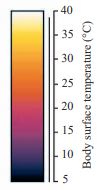
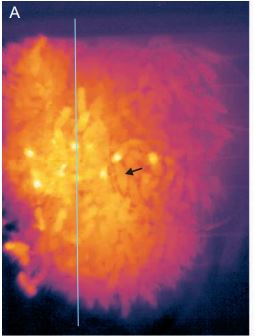 Note that the bees in the insulating shell, although they are generating heat, allow their abdomens (dark blue) to cool to as low as the low 40s F. But the authors show that the heads of those shell bees are warmer than their thoraces, meaning that they are receiving heat from the core. In the thermograph above, you can see some of the “heater bees” in the core (the queen’s position is indicated by the arrow).
Note that the bees in the insulating shell, although they are generating heat, allow their abdomens (dark blue) to cool to as low as the low 40s F. But the authors show that the heads of those shell bees are warmer than their thoraces, meaning that they are receiving heat from the core. In the thermograph above, you can see some of the “heater bees” in the core (the queen’s position is indicated by the arrow).
Stabenthaler’s data indicates that most bees in the core generate heat at a low level, but that some really ramp up heat production from time to time. Similarly, only a small fraction of the bees in the mantle appear to generate heat at an exceptionally high rate.
The findings of Kovak (Kovak (2007) Respiration of resting honeybees. J Insect Physiol. 53(12): 1250–1261) indicate that a bee’s basal metabolic rate increases as its environment warms from 50F to 95F. As Heinrich explains, that basal metabolic rate is enough for the inner bees to cook themselves if that heat isn’t dissipated out of the cluster. Thus, the job of the bees in the mantle is to tighten or loosen to conserve or dump heat (by opening ventilation passages). The larger the cluster, the more prone it is to overheating! Thus, the mantle bees need only to stay above chill coma temperature, in order to produce a temperature gradient from the warm core to the outside of the cluster, so that excess heat can escape, and to contract if necessary to conserve heat if necessary.
For the above reasons, it’s generally to the colony’s benefit to be larger — up to a certain extent. As well described by Heinrich, the more bees in the cluster, the greater the ratio of metabolic heat production to heat loss from the outer shell, and the cluster is thus able to maintain a higher core temperature. Indeed, once a cluster gets to around volleyball size, at times the bees in the insulating shell may be forced to expand outward to avoid inadvertently overheating the core (the maximum desired temperature would be 95˚F (35˚C). Anyone who has shaken bulk bees will understand how quickly a large cluster of bees can overheat. The bees in the shell “loosen up” in order to increase the cluster’s heat-radiating surface area, as well as to allow the convective “leakage” of warm air from the core out the top of the cluster.
Practical application: Thus the cluster expands or contracts (Fig. 5) to bring its rate of heat production into equilibrium with its rate of heat loss, maintaining a temperature at its periphery just warm enough for the bees in the shell to avoid chilling, yet not too warm in the core [15]. Presumably, the bees in the shell cluster more tightly when they get cold, but it’s not yet clear exactly which cues cause them to expand outward.
This warm core also offers the colony another option—it can now rear brood, if so warranted, by raising the broodnest temperature to a closely regulated 94–95˚F (34–35˚C). Stabentheiner [19], used a thermal imaging camera to show exactly how a relatively small proportion (around 15%) of the bees in the core act as “heater bees” [20] (Fig.6), intensely generating heat where needed; the rest of the bees passively enjoy the warm nursery. Of interest is that some of these “heater bees” make occasional brief (less than 10 second) forays to the surface of the cool shell, perhaps to monitor the outside temperature. Or perhaps to obtain moisture in the high-humidity shell. Conversely, the bees in the shell may need to make trips to the core in order to evaporate excess water from their guts (in order to avoid dysentery), or to allow their body enzymes to catch up on metabolic processes at an optimal temperature.
Figure 6. By isometrically vibrating their wing muscles, individual “heater bees” bees typically generate thoracic temperatures of 95F (35C), but some reach extremes of 115F (47C). Relatively few bees actually engage in heating, and each only produces heat sporadically as needed to maintain the temperature of its immediate surroundings. This beautiful thermographic photo is from Stabentheiner (2010) [[i]].
[i] Stabentheiner A, et al (2010) Honeybee colony thermoregulation – regulatory mechanisms and contribution of individuals in dependence on age, location and thermal stress. PLoS ONE 5(1): e8967.
The heat generated by the bees in the core can be trapped so efficiently by the insulative shell of bees on the outside, that the temperature of the core can rise to dangerous levels [22]. In response, the hot bees trapped inside the insulating shell perhaps [23] push their heads against the inward-facing shell bees, which would both transfer heat outward, as well as give a signal to the shell bees to loosen up, thus increasing the surface area of the cluster (for greater heat loss), as well as opening up upper passageways in the comb interspaces through which warm air can escape by convection currents.
Figure 5. ARS scientist Charles Owens at Madison, Wisconsin recorded over a million temperature readings from 2000 thermocouples placed in square hives consisting of three medium brood chambers. I snipped one of his many graphs to illustrate how the cluster contracted in response to the temperature dropping from 44˚ to 2˚F over the course of two days. I added red arrows at the approximate 48-65˚F isotherms to indicate the thickness of the insulating shell of bees, and to show how it loosens when warm (to release heat), and compresses tightly when cold (to conserve heat). Note that the core was above 90˚F in the beginning, but dropped to about 80˚F by the end (the cluster was apparently broodless), and how the 76˚ isotherm at the lower right was only about an inch from the 25˚ isotherm—indicating how effectively the cluster conserves its heat. After Owens 1971 [[i]].
[i] Owens, CE (1971) The thermology of wintering honey bee colonies. USDA Technical Bulletin 1429. Owens apologized for not using isotherms that clearly indicated the location of the insulating shell. I added circled isotherm labels for clarity.
Practical application: any beekeeper can observe the expansion and contraction of the cluster in response to temperature. However, it is best to not disturb the cluster unless it has “broken,” which generally occurs at ambient temperatures of above 50˚F (10˚C). Disturbing a large, tight cluster can result in extreme stress to the colony, and sometimes sudden death.
Regulation of Gases in the Cluster
It is critical for the colony’s survival to minimize its consumption of honey stores over the winter. The physical arrangement of the heating and insulating bees produces an extremely energy-efficient cluster. At times, perhaps too efficient–even the resting metabolic heat output from the bees in a large cluster may produce so much heat that the cluster may be forced to expand (for cooling) to a point that it wastes precious energy. Van Nerum and Buelens [24] ask the trenchant question: “Are high temperatures [in the core] functional or are they merely a side effect?”
They found that the bees have yet another trick up their sleeve—by creating a near perfect hermetic seal in the shell of insulator bees (which needs to restrict air flow only in the beeways between the combs), they can actually control the amount of oxygen, CO2, and moisture in the trapped air, and thus go into a diapause- (or hibernation-) like state of reduced metabolism.
Wintering clusters appear to exhibit a metabolic rate lower than the “resting” metabolic rates of the individual bees combined, indicating that the bees in the winter cluster are able to reduce their metabolic rate even further than that of a normal “resting” bee. They appear to do so by going into a “hypoxic” (low oxygen) state.
The normal concentrations of oxygen and CO2 in the atmosphere are 21% and 0.04% respectively [25]. In the tight confines of the cluster, the ratio of those gases changes dramatically—oxygen drops to around 15% and CO2 rises dramatically to 6-10% (a concentration high enough to kill a human). Only at the high end of that range do the bees in the core initiate audible fanning to freshen the air [26].
Practical summary: it’s not clear exactly which cues (or combination thereof) cause the bees in the shell to expand. Cues could be the temperature that they sense with their heads, an intolerable level of CO2, or perhaps the fanning and pushing of the bees in the core as they become agitated due to excessive temperature or CO2 [27].
In any case, Van Nerum experimentally demonstrated that in a hypoxic atmosphere, bees greatly reduce their metabolism, until CO2 exceeds a certain level. This trick appears to be of benefit to the colony in that it helps it to conserve honey stores. Furthermore, it may be important for its conservation of water…
Water Conservation
A beekeeper soon learns that too much moisture in the hive during the winter is really tough on the bees (Fig. 7).
Figure 7. This hive was inadvertently tipped backward slightly during winter, thus preventing water from draining out the entrance. I find that a wet bottom board in winter often spells death to a colony.
Beekeepers often go to great measure to avoid moisture buildup in the hive during winter. One should do so with caution, as explained in a fascinating article by Möbus some time ago in this Journal [28]. He points out the bees in a cluster are often desperate for water, and that the larger the cluster, the more likely they are to suffer from dehydration.
Similarly to us, an insect loses moisture with each exhaled breath (unless it is in a 100% relative humidity environment). Insects use every trick in the book to avoid dehydration, and bees are no exception. Bees breathe only about twice a minute, unless they are generating heat, at which time one can easily observe them pumping their abdomens more rapidly to bring in oxygen and release CO2. But they must open their spiracles when the CO2 content of the air increases (as in the winter cluster), and thus lose water even more rapidly.
Bees in the cluster consume honey for energy, but must dilute it with water in order to digest it. So where do they get that water? When the colony breaks cluster on warm winter days, you can see workers desperately foraging for water. The rest of the time, the colony must conserve its precious moisture. To start with, they seal the interior of the cavity with propolis and wax, in order to make the surface relatively impervious to water. And then they take advantage of relative humidity and condensation.
Relative humidity is the percentage of water vapor in air relative to the amount that it could hold if fully saturated at that temperature (the warmer the air, the greater the amount of water than it can hold). Similar to the effect of causing very low humidity by heating the air in a house during winter, the relative humidity in the warm core of the cluster will be quite low, causing the bees there to be perpetually thirsty. On the other hand, water vapor condenses into liquid water on surfaces that are below the dew point (the temperature that water vapor at a given relative humidity will start to condense).
Roughly 6/10ths of a pound of water is released during the digestion of a pound of honey [29]—most of it “metabolic water” from the breakdown of sugar into CO2 and water. That means that a non-flying colony consuming a typical third of a pound of honey per day produces roughly a half cup of water vapor per day. Möbus shows a table of metabolic water production and loss from bees’ bodies at different temperatures. The table indicates that the warm bees in the cluster core would lose water, whereas the cool bees in the insulating shell would gain it. We’d expect much of the metabolic water from to core to condense upon the cool comb (perhaps diluting the honey in opened cells) or upon the bodies of the bees in the shell, from whence it somehow gets passed back to the bees in the core [30], perhaps with the honey passed from the shell of bees on the periphery of the cluster to the hungry bees in the core.
There is also the issue of heat recovery from that water vapor that is released from the cluster each day. It takes roughly a half a Calorie to vaporize a gram of water; that energy can be recovered by condensing that water vapor on a cool surface (any surface below the dew point of the escaping warm air from the cluster). Keep in mind that water vapor is less dense than air. As a result, unless the tightly packed shell of bees restricts it, the heated, water vapor rich air in the cluster will rapidly escape out of the upper passages between the combs.
Much of this water vapor will condense within the cool outer shell of bees, thus trapping its heat within the core. But if a colony is consuming a third of a pound of honey a day, it must also release the quarter pound of water vapor produced each day (either ventilated out as vapor, or running out the entrance as liquid). That vapor contains roughly 12% of the energy in the honey consumed. If that vapor condenses on the combs or cavity walls surrounding the cluster, that released “latent heat” will warm the space around the cluster, thus saving it energy (especially if it is released below the cluster; I’ll return to this subject when I discuss hive design).
Summary
In the next installment, I’ll continue with the biological and practical aspects of the winter cluster, such as food consumption, dysentery, disease, and hive design. But I thought I’d wrap up this discussion by creating the diagram below in an attempt to summarize the physical processes taking place within the winter cluster (Fig. 8).
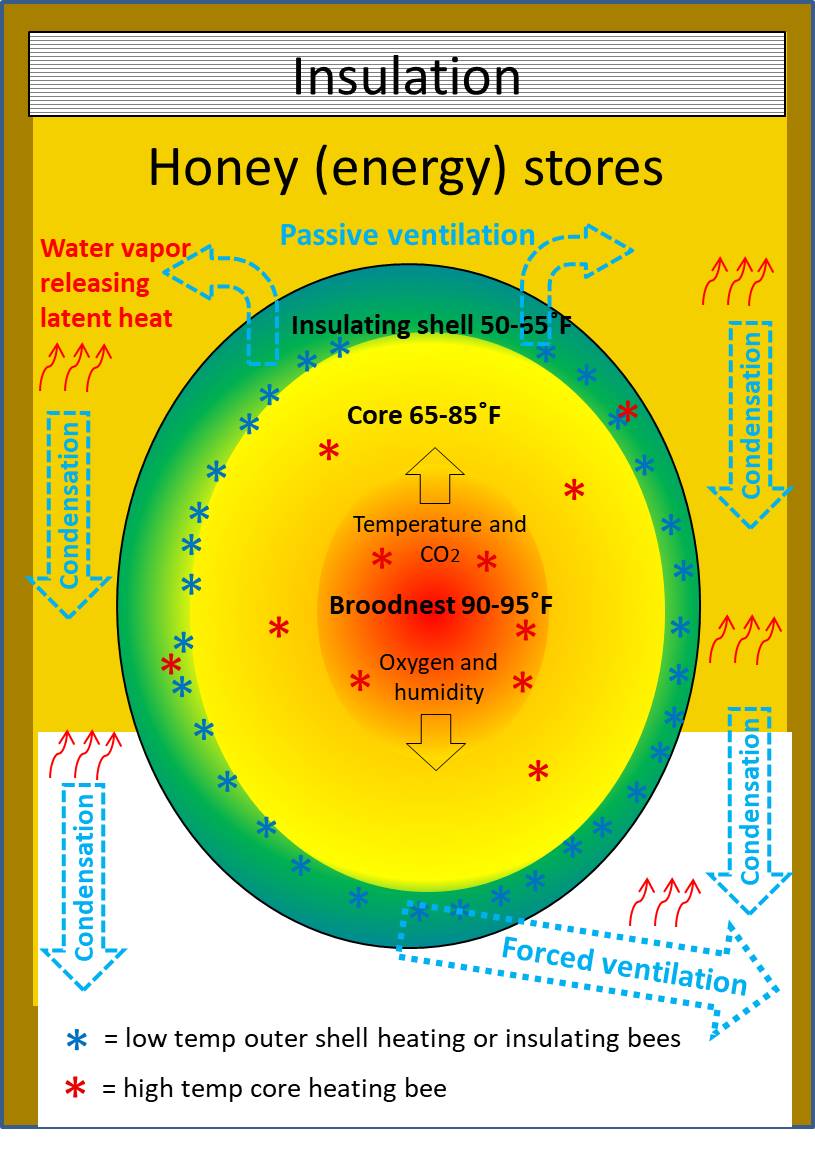
Figure 8. In this stylized diagram, I’ve illustrated the physics taking place in the winter cluster. The large mass of tightly-packed, inward-facing bees in the insulating shell continually generate (asterisks) just enough heat to remain above chill temperature—pumping that heat inward from their thoraces to their heads (allowing their abdomens to chill). Scattered bees in the core raise their thoracic temperatures to heat up their surroundings, which may then force the shell bees to loosen up and expand the size of the cluster. If the colony needs to rear brood, heater bees in the center of the core will tightly regulate temperature there to around 954F.
I’ve drawn arrows to indicate that as temperature goes up in the core, the levels of oxygen and relative humidity drop dramatically, while CO2 rises to sky high levels. Water vapor escapes the cluster along with the heated air, giving up its latent heat as is condenses on the surfaces surrounding the cluster, thus reducing radiant heat loss.
Bottom line: although a number of researchers have dedicated a great deal of time in investigating the winter cluster, the dynamics of heat production, bee behavior in regulating cluster size, and water and food transfer and conservation, much yet remains poorly understood. I’ve done my best to digest and summarize what we know, but there is still much yet to learn.
Acknowledgements
Our understanding of the physics of the winter cluster comes from countless thousands of hours of tedious and meticulous measurements and experiments by bee researchers. We beekeepers owe them a debt of gratitude, and should do all we can to support the next generation of researchers. I’d also like to express my gratitude to my colleague Peter Borst and Dianne Behnke for their timely assistance in literature research as I rushed to complete this article.
Notes and Citations
[1] The only insect that I can think of that does this. Other insects overwinter in an inactive dormancy in the developmental stage (egg, larva, pupa, or adult) best adapted for surviving the cold. They do so by either producing antifreeze compounds or allowing their hemolymph to freeze, or by finding haven deep in the soil or water, or as a parasite on a warm-blooded mammal or bird.
[2] Southwick, EE (1982) Metabolic energy of intact honey bee colonies. Comp. Biochem. Physiol 71A: 277-281.
[3] Southwick 1982 op cit. He quantified metabolic rates by measuring oxygen consumption. Note that he interprets his data differently in his 1983 paper.
[4] Southwick 1982 op cit.
[5] Omholt, SW (1986) A model for intracolonial population dynamics of the honeybee in temperate zones. Journal of Apicultural Research 25(1): 9-21.
Watmaugh, J & S Camazine (1995) Self-organized thermoregulation of honeybee clusters. J. Theor. Biol. 176: 391–402.
[6] Trying to make sense of the literature is tough, since many studies are in different languages, various authors use centigrade or Fahrenheit to measure temperature, and calculate energy consumption in watts/hr, kcal/hr, joules, mL O2/hr, mg glucose/hr, etc. Trying to make the conversions, as well as conflicting data even from the same author, can make your head spin!
[7] Johansson, TSK & MP Johansson (1979) The honeybee colony in winter. Bee World 60:4, 155-170.
[8] Simpson, J (1961) Nest climate regulation in honey bee colonies. Science 133 (3461): 1327-1333.
[9] Stabentheiner, A, et al (2003) Endothermic heat production in honeybee winter clusters. Journal of Experimental Biology 206: 353-358. Open access, with beautiful thermal images. See his Fig. 2.
[10] Southwick, EE (1983) The honey bee cluster as a homeothermic superorganism. Comp. Biochem. Physiol. Vol. 75A(4): 641-645.
[11] Heinrich, B & H Esch (1994) Thermoregulation in bees. Am. Sci. 82: 164–170.
[12] Simpson (1961) op cit.
[13] Omholt, SW (1987) Thermoregulation in the winter cluster of the honeybee, Apis mellifera. J. Theor. Biol. 128:219-231. An excellent theoretical model. He also points out that his temperature also best conserves water in the cluster.
[14] Heinrich, B (1981) The mechanisms and energies of honeybee swarm temperature regulation. J. Exp. Biol. 91: 25 – 55. Heinrich’s fascinating papers and books are must reads for those wishing to gain a deeper understanding of bee biology.
[15] Most of the bees (~13,000) in a volleyball-sized cluster will be in the insulating shell, leaving a softball-sized core at a higher temperature. This small core would not allow much broodrearing unless the cluster upped its heat production in order to allow it to expand a bit.
[16] Owens, CE (1971) The thermology of wintering honey bee colonies. USDA Technical Bulletin 1429. Owens apologized for not using isotherms that clearly indicated the location of the insulating shell. I added circled isotherm labels for clarity.
[17] This is roughly the same temperature at which a colony during summer holds combs outside the broodnest.
[18] Altman, cited by Möbus, B (1998) Rethinking our ideas about the winter cluster; Part II. ABJ August 1998: 587-591.
[19] Stabentheiner (2003) op cit. Stabentheiner’s measurements show whether a bee is producing heat, since its thorax will be warmer than its head. Only a portion (~10%) of the bees in the shell met this criterion in his relatively small observation hive. Unfortunately, heat generation is only clear for those bees that are intensely generating heat (such as those in the core); the measurements are more difficult to interpret when a bee is in a heat gradient, or to detect low-level heat generation (as in the bees in the shell).
[20] He used the term “endothermic,” meaning producing heat from the inside.
[21] Stabentheiner A, et al (2010) Honeybee colony thermoregulation – regulatory mechanisms and contribution of individuals in dependence on age, location and thermal stress. PLoS ONE 5(1): e8967.
[22] Researchers have occasionally measured temperatures in the core of above 100F (38C), apparently as the cluster is overshoots its target temperature.
[23] Pure speculation.
[24] Van Nerum, K & H Buelens (1997) Hypoxia-controlled winter metabolism in honeybees (Apis mellifera). Comp. Biochem. Physiol 117A(4): 445-455.
[25] CO2 was at only 0.032% when I was born. We humans are causing CO2 to rise relentlessly, which is having serious effects in the biosphere.
[26] Johansson (1979) op cit..
[27] Simpson, J (1961) op cit.
[28] Möbus, B (1998) Rethinking our ideas about the winter cluster; Part II. ABJ August 1998: 587-591.
[29] By my calcs, 77g of water in 17% moisture honey, plus 211 g of metabolic water produced from the digestion of the sugar, from a pound of honey.
[30] Simpson, however, notes that such condensation is not visible on or immediately adjacent to the shell bees.




